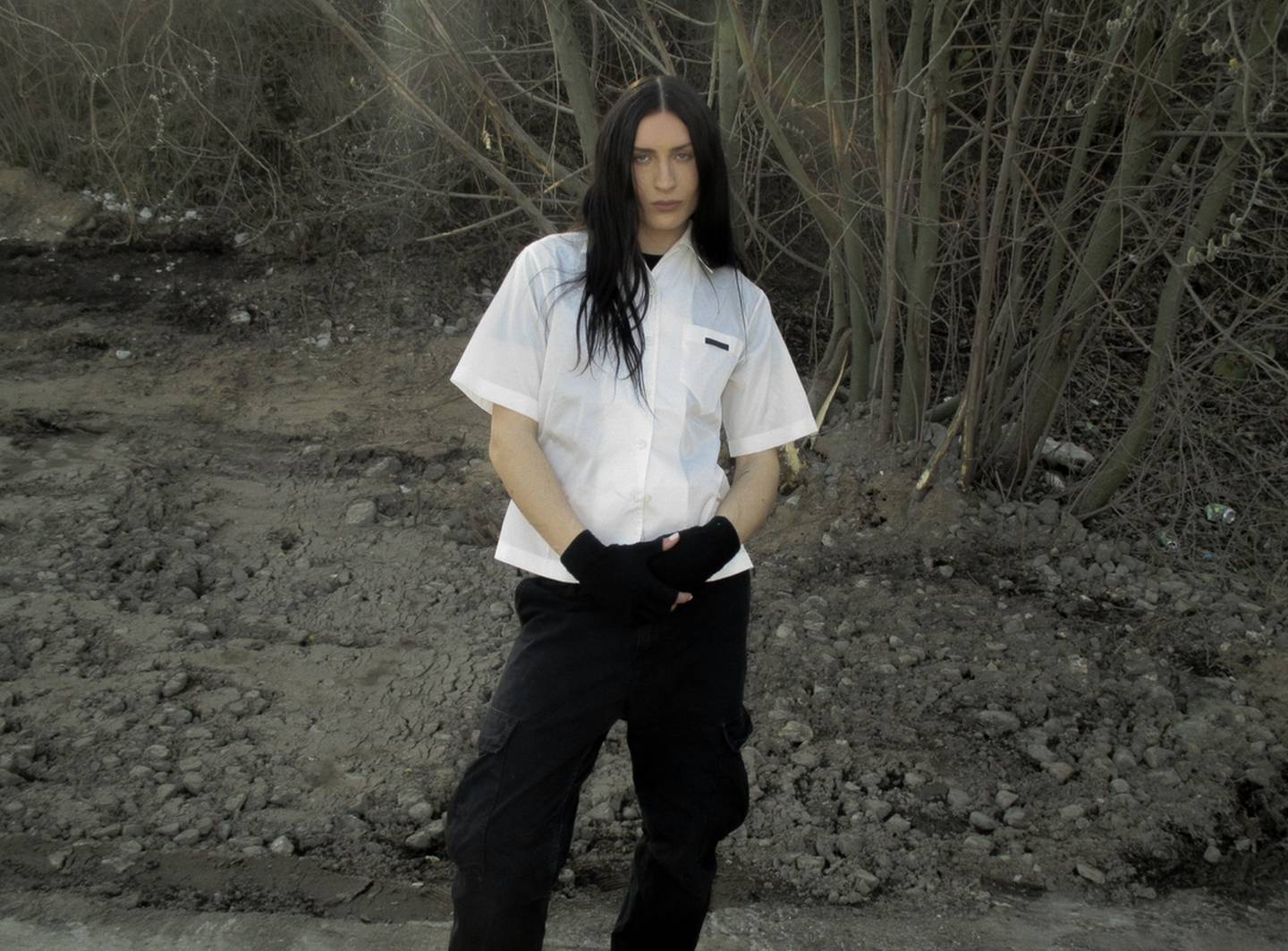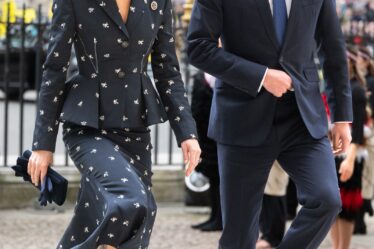
If there is a quality that defines the phenomenon that is Ras Baun Bartram, it might be speed. It’s been a whirlwind few months for the Danish stylist. In late January, the 20-year-old was named fashion director at 032c, the influential Berlin-based magazine that has grown into a fashion label in recent years, with regular ready-to-wear presentations and apparel drops.
But the announcement couldn’t surpass the buzz around Bartram less than three weeks earlier. On January 10, the rapper and designer now legally known as Ye had used a college football broadcast to release a video for ‘Heaven and Hell,’ a track off his album Donda. In a feat of canny covert marketing, the darkly enigmatic video — featuring masked and hooded figures swirling into the clouds like in an El Greco painting — doubled as a teaser for Yeezy Gap. It was styled by Bartram.
Joerg Koch, founder and editor-in-chief of 032c, says he offered Bartram the position just two days after a chance encounter in Florence in January of this year resulted in Bartram styling a look book shoot for 032c’s Autumn/Winter collection. “I was struck by the way he operated, how quickly and intuitively he composed essential looks. I should add that not only the speed was astonishing, but also the impressive precision,” said Koch. “Ras’ aesthetic isn’t even fully discernible yet, but you can already see there is a clear worldview, not to mention globe-spanning ambition.”
“I grew up in the digital age. For me everything has gone super-fast, very different from the generation before me.”
Bartram knows his rise has come quickly. “I am 20 and have done a lot,” he said. “I grew up in the digital age. For me everything has gone super-fast, very different from the generation before me. As a young boy, I didn’t have to wait for the latest issue of some magazine to come out to stay informed. I could take the initiative and go online to research and educate myself in the basics of how the fashion industry works from my room. I think it’s going to be more common.”
Bartram was born in Copenhagen, where he grew up exposed to the worlds of media, sports and entertainment. His mother, Line Baun Danielsen, is a well-known journalist and former talk show host while his father, Jan Bartram, played for Denmark’s national soccer team. Ras credits them for instilling a sense of confidence and determination in him. “They both had dared to go in a direction different from their peers. That way of thinking stuck with me. To take chances and not be afraid of learning by doing — it’s how I approach everything I do.”
Bartram’s parents encouraged his interests. “I was a weird kid who preferred staying home reading fashion magazines, drawing or browsing the internet for anything pop- and fashion-related,” he recalls. “They let me learn sewing instead of going to soccer class.” When he was around 11, he took his father to a local store he loved. “I saw these platform Buffalos and told my dad I needed to have them.” Bartram’s father agreed to buy his son the footwear he coveted, under one condition — that he would actually wear them. “As we walked out, he made me put these 10-inch shoes on. That gave me confidence, no one in my town dressed like that.”
For a precocious boy, costume-making proved an irresistible portal to the fashion industry. “After school I hung out with some of my mom’s friends who designed clothing for Danish pop stars, putting rhinestones on a singer’s angel wings for a performance and so on,” he says. “I knew I was very interested and felt at home in this crazy world.”
Around age 15, Bartram had an epiphany, “I realised fashion is a huge community of people doing all sorts of things and wondered what my position in this vast network would be.” His relationship to clothes shifted from being a virtual hobby — “a playground where I could express myself in a way I couldn’t in real life” — to a career ambition. He was determined to be a stylist. “I would show up to school with Steven Klein images, which no one understood. It fascinated me to learn there was someone behind the amazing things people like Bowie and Lady Gaga wore. I knew without a doubt this was what I wanted to do.”
Bartram taught himself the mechanics of his dream job, but his role models weren’t stylists. “I grew up in a pop bubble, drawn mainly to music and fascinated by the goth scene before even knowing what it was. In terms of style, I looked up to people like Madonna, who were crazy and super sexy but had a dark twist to them.” Alexander McQueen was also a strong influence. (Only nine when McQueen died, Bartram discovered the designer through books).
Bartram’s first real job was assisting the Copenhagen stylist Maya Soul Paustian. After that, he spent some time building his portfolio, “creating cool pictures and visuals with friends, on random trips to Belgrade and other cities, collaborating with photographers and creative directors.” All along Bartram kept honing his aesthetic, which he describes as “timeless, sexy, stark, and always with a twist of bizarre.” “My goal is to bring ‘ugly’ elements into what sexy is today, always with a hard edge.” It caught the eye of one megastar tastemaker.
By far, working with Kanye West has been Bartram’s biggest break. The musician’s team contacted Bartram in the spring of 2021. “They had seen some of my earlier work and he liked my aesthetic. I began styling and researching for him, in different fields of his universe.” Bartram works directly for West and is bound to secrecy regarding the details of the collaboration, but says about his celebrity mentor, “He really gave me a platform where I could express my creativity with the right resources and mindsets. And he pushed me in knowing my full potential. Being on the Yeezy Donda team has been like an education.”
These days Bartram lives nomadically, shuttling between Berlin and Copenhagen with stints in Paris and Milan. He has a penchant for mixing women’s garments into his wardrobe and considers styling a deeply personal profession which involves exposing vulnerable parts of himself (you don’t get to work with Ye making safe choices). “My styling decisions relate completely to who I am as a person. Good styling requires one to open up one’s soul, to share your personal aesthetic and blend it with the environment you’re styling in. It’s only when you take risks and follow your gut intuition that you stick out from the pack.”
But he’d like to clear up the misconception that his work or personal style are a comment on gender. “It isn’t a factor for me. Two people of the same gender but with nothing else in common could wear the same dress or suit and you’d have two completely different looks. It’s all about expression and attitude. It amuses me that people see my styling as provocative, or think I am trying to push boundaries. They assume things about my intentions and what pronouns I use.” (Bartram uses he/him) “I simply don’t limit myself. Not on any front but especially not in my work. I would never work anywhere with strict rules on how a guy or a girl is supposed to look.”

If the way Bartram presents is often described as androgynous or daring, the stylist insists that’s the product of outdated assumptions. “I am just being Ras. It’s not something I can tone down, but I’m not waving a flag. I am proud of my work and who I am.” And yet, it isn’t lost on him that at this moment in time, his audacity can read as a hopeful, hard-earned, political stance.
“Of course, I am also proud of how I look and what I represent, because I do represent something. If I had seen more people like myself growing up, guys who like to dress and express themselves differently, I would have had an easier upbringing. Luckily, today I’m not that rare, because we are growing as a society, and becoming more respectful of each other.”
Bartram’s main current focus is on 032c. The cutting-edge culture journal was founded by Koch in 2001 — making it the same age as the Danish wunderkind now helming its fashion pages — as a purely editorial venture, the brainiest fashion glossy of its time. But once it entered its second decade, 032c began to slowly rebrand itself as a streetwear and fashion label, debuting a women’s collection in 2020 (all while continuing its vanguard editorial mission. Before Bartram, the fashion director position was held by Mel Ottenberg then Marc Goehring.)
The addition of Bartram to its team comes at a critical time for 032c, as the magazine and the label it spawned plan to expand with a store in Berlin, set to open in April (with an installation by Sterling Ruby), and a second physical space by early 2023 in Paris (where a runway show is also planned for next January). Bartram will work across all of 032c’s endeavours.
“The scope of what 032c is has increased incredibly — it’s a platform, a fashion label, a print magazine, and soon will have stores in various cities. We needed a new fashion direction that reflected that grander scale,” explains Koch, “We were really hoping to find someone interested in working throughout all channels, and all formats, to define the fashion point-of-view of 032c.”
Bartram will unveil his vision for the magazine in May, when the biannual’s first issue under his fashion direction arrives on newstands. He says he has a strong chemistry with his new employer. “I am excited for 032c going from being mainly a media brand to becoming a proper fashion brand. We are ready to push the fashion energy both in print and digital. I have a foot in all camps, working with the 032c ready-to-wear team and with the editorial team on stories.”
He then adds, with characteristic confidence, “Look, the reason I work here is I understand 032c’s universe. That said you’re going to get my take on 032c, you’re going to be able to say, ‘Ras is here.’ It will have my stamp — and we are going to create a new language.”



